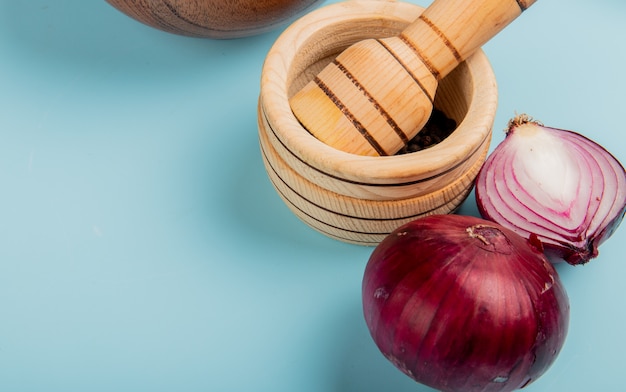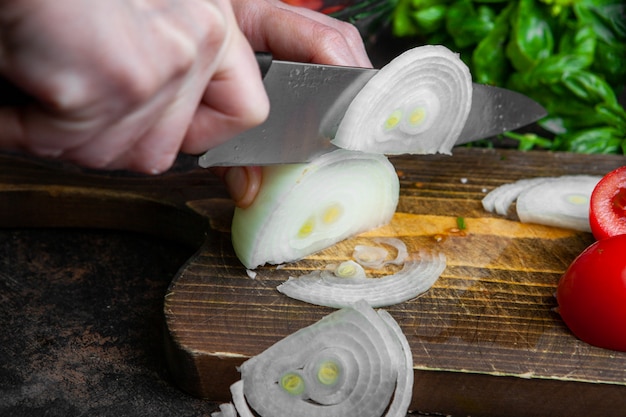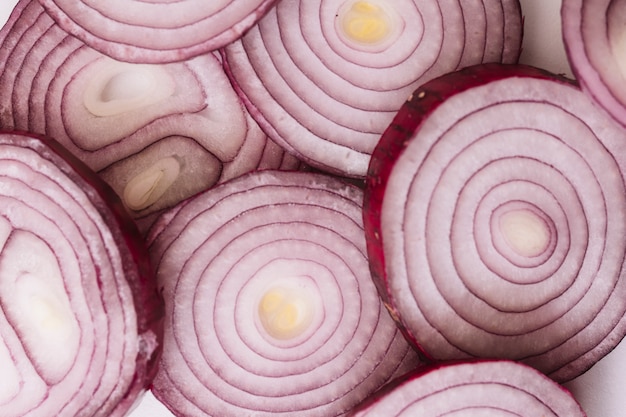(Part 1) Choosing the Right Onions: Understanding Your Options

The Great Onion Debate: What's the Difference?
The first step to mastering the onion is understanding your options. You've got yellow, red, white, shallots – the list goes on! But what's the real difference between them? It all comes down to their sweetness, sharpness, and how they behave when cooked.Let's start with yellow onions, the workhorses of the kitchen. They have that classic, strong onion flavour we all know and love, and they hold their shape well when cooked. Great for frying, sauteing, and even roasting. They're super versatile – you can use them for pretty much anything.
Then there are red onions, known for their vibrant colour and milder flavour. They've got a bit of a sweetness to them, making them perfect for salads and salsas. When cooked, they tend to become softer and less crunchy, so they’re great for adding colour and flavour to dishes.
White onions are the sharpest of the bunch. Think of them as the sassy, bold one of the onion family. They're usually used raw in things like sandwiches and dips because they hold their crunch well. But don’t be afraid to cook them! Just remember, they’ll have a stronger, more pungent flavour than their yellow and red counterparts.
And let’s not forget shallots! These little beauties are a sort of hybrid between onions and garlic. They have a milder, sweeter flavour than regular onions, making them a fantastic addition to sauces and dips.
Picking the Perfect Onion: A Guide to Choosing the Best
Now, you've got your onions – but are they actually good? Don’t just grab any old onion. Here's how to pick the best ones:- Firm and Heavy: A good onion should feel heavy for its size. Avoid ones that feel soft or squishy. That's a sign they’re starting to go bad.
- Dry and Unblemished: Look for onions that are dry and free from any cuts or bruises. A little bit of damage isn't a deal-breaker, but you want to avoid ones that look like they’ve been through a war.
- No Sprouts: Sprouts are a sign that the onion is getting old and losing its flavour. They're also a bit annoying to deal with.
Storing Onions: Keeping Them Fresh for Longer
So you’ve got your perfect onions. Now, how do you keep them that way?The key is to store them in a cool, dry place – think your pantry or a cupboard. You can even store them in a paper bag to help them breathe. Just don’t store them in the fridge, as that will make them go soft.
(Part 2) Preparing Onions for Cooking: Minimizing Tears and Maximizing Flavour

Peeling and Chopping: A Guide to Avoiding Tears
Let’s face it, peeling onions can be a real tearjerker. But fear not, there are ways to avoid that watery misery. Here's the secret:- Cold Water Soak: Before you start, give your onion a quick cold water soak. This will help to reduce the release of those tear-inducing compounds.
- Ventilation: Work in a well-ventilated area. Or, if you're really feeling brave, you can try using a fan.
- The "Onion Mask": This one might sound a bit silly, but it works! Try wearing a mask or goggles to protect your eyes from those onion fumes.
- Chewing Gum: Some people swear by this one. Apparently, chewing gum while you chop can help to absorb those tear-inducing compounds.
Chopping Techniques: The Right Cut for the Right Dish
Now that you've got your onion peeled and ready to go, it's time to chop it. And the way you chop your onion can really affect the final result.Thin slices: Great for sautees and stir-fries, where you want the onion to cook quickly and evenly.
Dice: A classic cut for soups, stews, and curries. They add a nice bite of texture to your dishes.
Julienne: These long, thin strips are perfect for stir-fries, salads, and even garnishes.
Rough chop: A bit more rustic, but it works well for roasted onions or when you're just looking for a quick and easy chop.
(Part 3) Cooking Onions: From Basic Sautéing to Masterful Caramelization

The Art of Sautéing Onions: A Simple and Versatile Technique
Sautéing is a basic cooking technique that’s super useful for onions. It’s all about getting those onions nice and soft, with a bit of colour.Here's how to do it:
- Heat your pan: Heat a little oil in a pan over medium heat. Don't use too much oil, or your onions will end up swimming in it.
- Add the onions: Add your chopped onions to the pan and cook, stirring occasionally, until they start to soften and turn translucent. This usually takes about 5 minutes.
- Season to taste: Once they’re soft, season your onions with salt and pepper to taste.
Caramelizing Onions: Patience, Precision, and Sweet, Delicious Rewards
caramelized onions are a culinary masterpiece. They’re sweet, soft, and bursting with flavour. They’re also a bit of a time commitment, but trust me, the wait is worth it.Here’s what you need to know:
- Low and slow: Caramelizing onions is all about low heat and patience. You want to cook them over low heat, stirring occasionally, for about 30 minutes, or until they’re dark brown and caramelized.
- The Sugar Trick: A pinch of sugar helps to accelerate the caramelization process. Just add a little bit of sugar to the pan with your onions, and it’ll help them to brown more quickly.
- Don’t Overcrowd: Make sure your onions have enough space in the pan to cook evenly. If you add too many, they’ll steam rather than caramelize.
The Difference Between Sautéed and Caramelized Onions: A Quick Breakdown
A lot of people get sautéing and caramelizing mixed up. Remember this:Sautéed onions are soft and translucent, with a light colour. They're great for adding a base flavour to your dishes.
Caramelized onions are deep brown and intensely sweet. They're a delicious topping for burgers, sandwiches, and pizzas.
(Part 4) onion recipes: From Classic to Creative
Classic Onion Soup: A French Favourite
Let's start with a classic – french onion soup. This dish is all about simple, comforting flavours.Here's what you'll need:
- 2 large yellow onions, sliced
- 2 tbsp butter
- 4 cups beef broth
- 1/2 cup dry red wine
- 1/4 cup flour
- 1/2 tsp thyme
- Salt and pepper to taste
- 1 baguette, sliced
- Grated Gruyere cheese
Instructions:
- Melt the butter in a large pot over medium heat. Add the onions and cook, stirring occasionally, for 30 minutes, or until they’re soft and caramelized.
- Stir in the flour and cook for 1 minute.
- Add the beef broth, red wine, thyme, salt, and pepper. Bring to a boil, then reduce heat and simmer for 15 minutes.
- Toast the baguette slices and top with cheese. Place the bread in the soup and let it sit until the cheese melts.
Spicy Onion Relish: A Zingy side dish
Next up, a delicious and spicy onion relish. Perfect for adding a bit of a kick to your meals.Here’s what you’ll need:
- 1 red onion, finely chopped
- 1/2 cup white vinegar
- 1/4 cup sugar
- 1 tbsp Dijon mustard
- 1 tsp salt
- 1/2 tsp black pepper
- 1/4 tsp red pepper flakes
Instructions:
- Combine all ingredients in a saucepan. Bring to a boil, then reduce heat and simmer for 10 minutes, or until the relish has thickened slightly.
- Let cool completely before serving.
Creamy Onion and potato soup: Comfort in a Bowl
Now for a creamy and comforting onion and potato soup. Perfect for a cold evening.Here’s what you’ll need:
- 2 tbsp butter
- 1 large yellow onion, chopped
- 2 cloves garlic, minced
- 4 cups vegetable broth
- 2 large potatoes, peeled and diced
- 1/2 cup heavy cream
- Salt and pepper to taste
Instructions:
- Melt the butter in a large pot over medium heat. Add the onions and cook, stirring occasionally, for 5 minutes, or until they’re softened.
- Add the garlic and cook for 1 minute more.
- Stir in the vegetable broth and potatoes. Bring to a boil, then reduce heat and simmer for 15 minutes, or until the potatoes are tender.
- Use an immersion blender to blend the soup until smooth.
- Stir in the heavy cream and season with salt and pepper to taste.
(Part 5) Onions in the World: From Global Cuisine to Everyday Meals
The Onion Around the World: A Global Culinary Staple
Onions are a global ingredient, used in cuisines all over the world.Here’s a quick rundown:
| Region | Cuisine | Onion Use |
|---|---|---|
| India | Indian Cuisine | Onions are a staple in Indian cooking, used in curries, stews, and as a base for many dishes. They are often roasted, fried, or caramelized to enhance the flavour profile of various dishes. |
| China | Chinese Cuisine | Onions are often used in stir-fries, soups, and dumplings. They can be added raw for a sharp bite or cooked for a milder flavour. |
| Mexico | Mexican Cuisine | Onions are a key ingredient in salsas, tacos, and guacamole. They are often diced raw or lightly sautéed to add a fresh, pungent flavour. |
| Italy | Italian Cuisine | Onions are used in pasta sauces, soups, and stews. They can be sautéed, caramelized, or roasted, depending on the desired flavour and texture. |
| France | french cuisine | Onions are famous for their use in French onion soup, but also in many other dishes, including stews and sauces. They are often caramelized for a sweet and rich flavour. |
Onions in Everyday Cooking: Adding Depth and Flavour to Familiar Dishes
Beyond global cuisines, onions are essential in everyday cooking.Here are just a few ways you can use onions in your everyday meals:
- As a base for sauces and soups: A sauteed onion base adds depth and richness to many sauces and soups. The onions create a foundation of flavour that can be enhanced with other ingredients.
- In stir-fries and sautéed dishes: Onions add a sweet and savory flavour to stir-fries, and they can also be used to make a quick and easy sautéed dish. They can be added at the beginning of cooking to soften or towards the end for a crisp bite.
- In sandwiches and burgers: Onions are a classic addition to sandwiches and burgers. They can be sliced raw, grilled, or caramelized for a range of flavour profiles.
- As a topping for pizzas and baked goods: Caramelized onions are a delicious topping for pizzas, and they can also be added to breads and other baked goods. Their sweetness complements the savoury flavours of pizza or the richness of baked goods.
(Part 6) Onions and Health: More Than Just Flavour
nutritional powerhouse: A Treasure Trove of Vitamins and Minerals
Onions are a good source of vitamins and minerals, including vitamin C, potassium, and folate. They also contain antioxidants, which may help to protect against certain diseases.Health Benefits: A Look at the Potential Advantages
Some of the potential health benefits of onions include:
- Lowering cholesterol: Onions may help to lower bad cholesterol levels, contributing to overall cardiovascular health.
- Improving blood sugar control: Onions may help to improve blood sugar control, especially for people with type 2 diabetes. Their fibre content helps regulate blood sugar levels.
- Reducing inflammation: Onions contain anti-inflammatory compounds, which may help to reduce inflammation throughout the body. This can be beneficial for managing various health conditions.
- Boosting immunity: The antioxidants in onions may help to boost your immune system, promoting a stronger defence against illness.
(Part 7) Onion Tips and Tricks from My Kitchen: My Personal Onion Wisdom
My Top Onion Hacks: Secrets to Success
Now for some of my personal tips and tricks. These are the things I've learned over the years that make my onion cooking life a little bit easier.- Freezing Onions: If you have leftover onions, you can freeze them for later use. Just chop them and freeze them in a freezer-safe bag. They'll be ready to add to soups, stews, or other dishes later.
- The Magic of Wine: A splash of white or red wine added to your onions during cooking will add a touch of sweetness and depth of flavour. The alcohol evaporates, leaving behind a subtle complexity.
- Onion Powder and Flakes: Onion powder and flakes are a great way to add onion flavour to your dishes without having to chop any onions. They’re super convenient for quick flavour boosts.
My Favourite Onion Recipes: A Personal Touch
I’ve already shared some classic recipes, but here are a couple of my personal favourites. These are the dishes I turn to when I want to impress myself or my guests.My go-to: grilled salmon with Caramelized Onions and Balsamic Glaze:
This dish is a symphony of flavours. The sweetness of the caramelized onions complements the richness of the salmon perfectly. The balsamic glaze adds a touch of acidity and tanginess, bringing everything together. It’s a delicious and elegant dish that always impresses.
My comfort food: Onion and Blue Cheese Quiche:
This quiche is a crowd-pleaser. The rich, creamy filling, with its sharp notes of blue cheese, is offset by the sweetness of the caramelized onions. It’s the perfect comfort food for a cold day. The contrasting flavours create a beautiful harmony that's both comforting and satisfying.
(Part 8) FAQs: Your Onion Questions Answered
1. Can you eat raw onions?
Absolutely! Raw onions are a great addition to salads, dips, and sandwiches. They have a sharp, pungent flavour that can add a nice bite to your dishes. If you’re looking for a milder flavour, try marinating your onions in vinegar or lemon juice before adding them to your dish.2. Why are my onions burning?
If your onions are burning, it’s probably because you’re cooking them over too high of a heat. Always cook onions over medium heat, stirring occasionally, to ensure they cook evenly and don’t burn. Keep a close eye on them, and adjust the heat if necessary.3. How do you know when onions are caramelized?
Caramelized onions are a deep brown colour and have a soft, sweet flavour. They should also be slightly sticky and have a syrupy texture. If your onions are still firm or have a raw taste, they’re not fully caramelized. Patience is key!4. Can you freeze caramelized onions?
Yes, you can freeze caramelized onions! Just let them cool completely, then place them in a freezer-safe bag. They’ll last in the freezer for up to 3 months. This is a great way to have them on hand for quick meals.5. What are the different types of onions?
As mentioned earlier, there are many types of onions. The most common types include:- Yellow onions: The most common type of onion, known for their strong flavour and versatility. They are a reliable choice for a variety of dishes.
- Red onions: A milder onion with a slightly sweet flavour, perfect for salads and salsas. They add a vibrant colour and a pleasant sweetness.
- White onions: The sharpest of the bunch, best used raw in dips and sandwiches. They provide a strong, pungent flavour that can be used to add a kick.
- Shallots: A hybrid between onions and garlic, known for their mild, sweet flavour. They offer a unique balance of onion and garlic flavours, making them a versatile ingredient.
- sweet onions: These onions have a very sweet flavour and are often used in salads and grilled dishes. They are known for their mild sweetness and are ideal for grilled dishes or salads.
Conclusion: Onion Mastery – The End of Your Culinary Journey (For Now)
Well, there you have it! That’s my ultimate guide to cooking onions. I hope you’ve found it helpful, informative, and maybe even a little bit inspiring. Remember, onions are a versatile ingredient, so don't be afraid to experiment and find what you love. And most importantly, have fun!Everyone is watching

How to Cook Frozen Lobster Tails Perfectly: A Step-by-Step Guide
RecipesLobster. Just the word conjures up images of lavish meals, special occasions, and a taste of luxury. But let's...

Pigs in a Blanket Cooking Time: How Long to Bake for Perfect Results
RecipesAh, pigs in a blanket. Just the name conjures up images of those delightful little parcels of crispy pastry en...

Pork Fillet Cooking Time: How Long to Cook It Perfectly
RecipesPork fillet, or tenderloin as it's sometimes called, is a real favourite in our house. It's so versatile, and...

The Ultimate Guide to Tender, Juicy Pulled Pork
RecipesRight, let's talk pulled pork. It's one of those dishes that just screams "comfort food," doesn't it? I mean...

The Ultimate Guide to Cooking Delicious Frankfurters
RecipesLet's face it, we all love a good frankfurter. It's a classic, simple, and always satisfying. But let's be rea...
